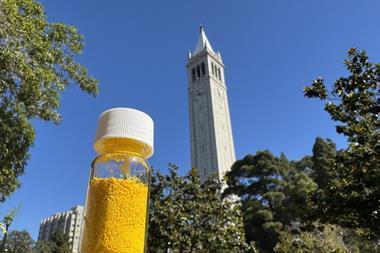A new metal–organic framework (MOF) structure functionalised with terminal zinc hydride sites can reversibly capture carbon dioxide at high temperatures.1 The material could enable easier, more energetically efficient capture of carbon from the exhaust gases of many industrial reactions. In future, it might also lower the temperature needed for some key processes.
The most mature technologies for capturing industrial carbon emissions are aqueous amines, but they only work at temperatures around 60°C or lower, whereas the exhaust gases from steel furnaces and cement kilns are vented at over 200°C. ‘You’re going to capture the carbon dioxide at low temperature and then release it at high temperature,’ says Jeffrey Long at University of California, Berkeley. ‘Temperature swings like that are usually inefficient.’

Instead, Long’s group has been experimenting with amine functionalisation of MOFs, which, as porous cage structures, are ideal for filtration. ‘Organic amines have a lot of degrees of freedom, and when you capture carbon dioxide two of [the amines] come together to make an ammonium carbamate ion pair – that locks them into place,’ notes Long. This means that there’s a large entropy change associated with capturing carbon dioxide with organic amines that disfavours the reaction at high temperatures, he explains.
In 2014, Dirk Volkmer at the University of Augsburg in Germany and colleagues showed that formates of a MOF called MFU-4l functionalised with zinc hydride groups could release carbon dioxide at low pressures.2 ‘What they didn’t realise is the reaction could be reversible at high enough temperatures,’ says Long.
Now, Long and his colleagues have shown experimentally and computationally that, when exposed to mixtures similar to flue gas from steel production, the material reversibly forms metastable formates with the carbon dioxide at temperatures above 200°C. As zinc hydride has few degrees of freedom, the formation has little entropic penalty. When the carbon dioxide concentration was lowered, the formate complexes broke down, releasing the carbon dioxide.

The researchers are now investigating the potential of similar MOFs to capture other gases at high temperatures. This could paradoxically lead to high-energy reactions requiring lower temperatures. ‘A lot of very high-energy reactions like the water–gas shift reaction that are run at 200 to 500°C are in equilibrium conditions,’ Long says. ‘One idea is to use a MOF … to actively capture carbon dioxide as it’s produced in the reaction.’ Driving the equilibrium towards the desired product could conceivably lower the temperature required. ‘For some of these systems, you might be able to drop the reaction down to below 200°C and then use geothermal energy to start driving the reaction,’ he adds.
‘There are many papers looking at carbon dioxide capture but this is the first one I’ve seen that works at these kinds of high temperatures,’ says Mircea Dinca at Massachusetts Institute of Technology in the US. ‘That’s definitely the thing that distinguishes it from other works. The finding is very significant – and unexpected I would say – first from a fundamental standpoint, but potentially practically too.’
References
1. R C Rhode et al, Science, 2024, DOI: 10.1126/science.adk5697
2. D Denysenko et al, Angew. Chem. Int. Ed., 2014, DOI: 10.1002/anie.201310004

















No comments yet